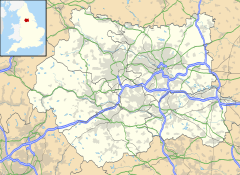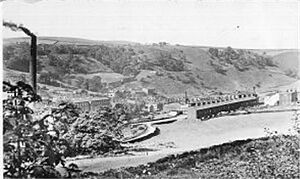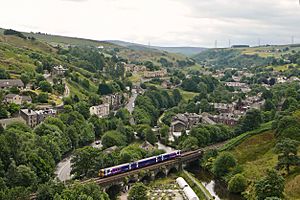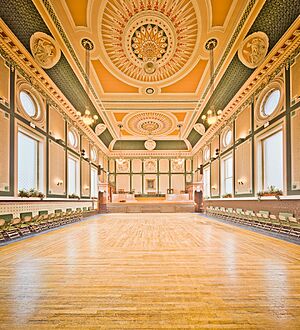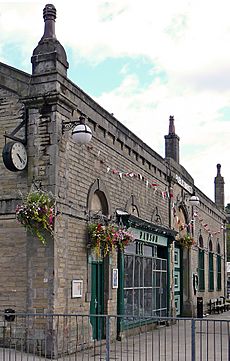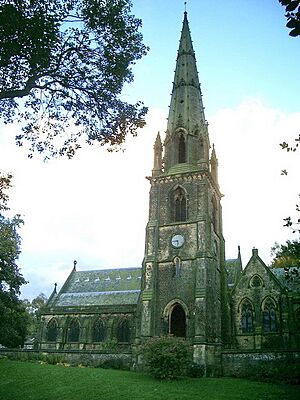Todmorden facts for kids
Quick facts for kids Todmorden |
|
|---|---|
 A view over Todmorden |
|
| Population | 15,481 (Including Cornholme and Portsmouth, West Yorkshire. 2011 census) |
| Demonym | Todmordian |
| OS grid reference | SD936241 |
| • London | 174 miles (280 km) SSE |
| Civil parish |
|
| Metropolitan borough |
|
| Metropolitan county | |
| Region | |
| Country | England |
| Sovereign state | United Kingdom |
| Post town | TODMORDEN |
| Postcode district | OL14 |
| Dialling code | 01706 |
| Police | West Yorkshire |
| Fire | West Yorkshire |
| Ambulance | Yorkshire |
| EU Parliament | Yorkshire and the Humber |
| UK Parliament |
|
Todmorden is a busy market town and civil parish in the Upper Calder Valley in Calderdale, West Yorkshire, England. It is about 17 miles (27 km) north-east of Manchester, 8 miles (13 km) south-east of Burnley, and 9 miles (14 km) west of Halifax. In 2011, about 15,481 people lived there.
Todmorden is where three steep valleys meet in the Pennines mountain range. It is surrounded by open moorlands with cool gritstone rocks shaped by wind.
The old border between Yorkshire and Lancashire counties used to run right through the town. This border followed the River Calder and a smaller river called Walsden Water. However, the official border was changed in 1888. Now, the whole town is part of West Yorkshire.
The town has two train stations: Todmorden and Walsden.
Contents
History of Todmorden
What Does the Name Todmorden Mean?
The name Todmorden was first used in 1641. Before that, it was called Tottemerden, Totmardene, Totmereden, or Totmerden. Most people agree that the name means "Totta's boundary-valley." This probably refers to the valley that goes north-west from the town.
Ancient Times in Todmorden
In 1898, a very old monument called Blackheath Barrow was dug up. It was a ring cairn, which is a circular stone mound. This site was found to be very important for history. People found items from the Bronze Age, like old pots, a human skull, teeth, and hands.
Experts believe Blackheath Barrow was a religious place. It was likely used for funeral ceremonies. The four stone piles, placed at the main compass points, suggest old rituals. These rituals might have been about spirits of the four directions. You can see the items found from this dig at the Todmorden Library today.
How Todmorden Grew Over Time
The first written record of this area is from the Domesday Book in 1086. In the Middle Ages, people in Todmorden lived in spread-out farms. They also lived in small farming villages on hilltops. Old stones still mark the trails used by packhorses back then.
For many years, streams from the hills powered mills. These mills were used for grinding corn and processing wool. Todmorden became quite successful by mixing farming with making woollen cloth. Some wealthy cloth makers built nice houses, and a few are still standing.
Later, the area started focusing more on cotton. Being close to Manchester, a big city for trade, helped a lot. Also, the strong streams in the Pennines could power the new machine looms. New machines and better roads helped the cotton industry grow. This also made the local population increase.
Todmorden in the 1800s
In 1801, most people still lived in the hills. Todmorden itself was just a small village. From 1800 to 1845, big changes happened in how people traveled and communicated. These changes helped the town's industries grow a lot.
New roads were built, and the Rochdale Canal opened in 1804. A main railway line, the Manchester and Leeds Railway, opened in 1841. This railway had the longest tunnel in the world at the time, called the Summit Tunnel. Another railway line to Burnley opened in 1849. These transport links made it easier for goods and people to move.
The Industrial Revolution changed Todmorden. Factories and homes moved to the valley floor. The town switched from making wool to making cotton. The Fielden family was very important to Todmorden. They built many large mills and impressive buildings. They also brought social and educational changes to the town.
Todmorden in the 1900s
At the start of the 1900s, Todmorden's population stayed about the same. After the First World War, the town's economy slowly declined. This got faster after the Second World War. Many mills closed, and heavy industries disappeared. This was a tough time for the local economy.
In 1907, Todmorden was one of the first towns in the UK to have a motor bus service. By the end of that year, they had five double-deck buses. In 1931, the bus service became a joint effort with the railway company. At its biggest, in the 1940s and 1950s, the bus service ran 40 vehicles over 50 miles (80 km) of hilly land.
Until 1938, Todmorden had six train stations. Most of them closed by the mid-1900s. However, Walsden station reopened in 1990. In 1984, a goods train carrying petrol crashed in the Summit Tunnel. This caused one of the biggest underground fires in transport history.
In 2008, local people started the Incredible Edible Todmorden project. This project wanted to make people think more about food. They planted 40 public fruit and vegetable gardens around the town. Anyone passing by can pick the produce for free. This project has become very famous and has been copied in many other towns.
How Todmorden is Governed

Todmorden has a complicated history of how it is governed. It sits right on the old border between Yorkshire and Lancashire.
Before 1888, the border ran through the middle of Todmorden. It followed the River Calder and Walsden Water. The Todmorden Town Hall, which opened in 1875, was built right over the Walsden Water. This meant that from 1875 to 1888, you could dance in the town hall ballroom and cross between two different counties!
After 1894, Todmorden became an Urban District Council. This included the areas of Todmorden, Walsden, Langfield, and Stansfield. In 1896, the town became a municipal borough. Since 1974, Todmorden has been part of the Metropolitan Borough of Calderdale, which is in West Yorkshire.
Most of the town is in the Todmorden ward of Calderdale Council. The eastern part of town, including Eastwood, is in the Calder ward. As of 2023, all the local councillors for Todmorden and Calder wards are from the Labour Party.
Todmorden's postal county was Lancashire until 1996, when postal counties were removed.
Todmorden Town Council
| Todmorden Town Council | |
|---|---|
| Type | |
| Type |
Town Council
|
| Leadership | |
|
Mayor
|
Cllr Tyler Hanley
|
| Structure | |
| Seats | 18 Councillors |
|
17 / 18
|
|
|
1 / 18
|
|
| Elections | |
| Plurality-at-large | |
|
Last election
|
2 May 2023 |
|
Next election
|
2 May 2027 |
| Meeting place | |
| Town Hall, Todmorden | |
The Todmorden Town Council has 18 councillors. In the 2023 local elections, only the Labour Party and the Liberal Democrats had candidates. The Labour Party won 17 seats, and the Liberal Democrats won 1 seat.
Todmorden's Twin Towns
Todmorden has two twin towns:
Geography of Todmorden
Other towns and villages in the Upper Calder Valley include Hebden Bridge and Mytholmroyd. The area of Todmorden also includes places like Eastwood, Walsden, Cornholme, Mankinholes, and Cross Stone.
In medieval times, Todmorden was made up of different areas. These included Langfield and Stansfield in Yorkshire. It also included the Todmorden/Walsden part of a larger area called Hundersfield in Lancashire. The area of Todmorden and Walsden was officially created in 1801. This happened when the older villages of Todmorden and Walsden joined together.
Todmorden's Economy
Heavy industry is now a part of Todmorden's past, not its present. Most of the old industrial chimneys are gone. The remaining mills have been changed for other uses. The town's industrial base is much smaller now. At one time, Todmorden had the largest weaving shed in the world!
Todmorden also serves the local countryside. It attracts visitors with its market (both indoors and outdoors), various events, and local history. The beautiful Pennine countryside also brings people in. For centuries, Todmorden has been known as the safest way to cross the Pennines.
Nightlife and Entertainment
In the town centre, you can find pubs like the Duke of York and the Wellington. The Golden Lion is a well-known place for live music. It even has its own record label.
The White Hart Wetherspoons pub closed in March 2024 after being sold.
Landmarks in Todmorden
The Todmorden Town Hall is a very important building in the town. It was designed in the Neo-Classical style. This grand building stands over the Walsden Water, a small river. It used to be in both Lancashire and Yorkshire until the county border moved in 1888.
The front of the town hall has a special carved section called a pediment. This carving shows the main industries of the two counties. On the left, a female figure represents Lancashire with cotton spinning and weaving. On the right, another figure represents Yorkshire with wool, engineering, and farming.
Todmorden looks like a Victorian mill town. Other famous buildings include Dobroyd Castle, finished in 1869. It is now used as a place for schoolchildren to do activities. There is also the Edwardian Hippodrome Theatre. The Grade I listed Todmorden Unitarian Church was built from 1865 to 1869.
Dobroyd Castle, the town hall, and the Unitarian church were all built because the Fielden family wanted them. They were designed by John Gibson, who also worked on the Houses of Parliament. Older buildings include two pubs from the 1700s. Todmorden Old Hall is an Elizabethan manor house from the 1500s. St. Mary's Church dates back to 1476.
Todmorden is located along famous walking and biking trails. These include the Pennine Way, Pennine Bridleway, and Calderdale Way. It's a great place for outdoor activities like walking, mountain biking, and bouldering. The town has canals, locks, a park with a sports centre, and a skateboard park. There are also tennis courts, a golf course, and a cricket ground. You can find wooded areas, cafes, and restaurants around town.
The Hippodrome Theatre shows movies and has live performances. The town has a small toy and model museum, a library, and a tourist information centre. There are also many independent shops. Every year, Todmorden has a carnival, an agricultural show, a beer festival, and a music festival. They also have traditional Easter Pace Egg plays.
Todmorden has many churches and chapels. The Todmorden Unitarian Church is very famous and is a Grade I listed building. Its tall spire is the highest point in the town. It is still used for religious services and community events. Other churches include the Central Methodist Church and St Joseph's Roman Catholic Church.
Centre Vale Park in Todmorden has several local art pieces. These include tree carvings by John Adamson. There is also a unique bandstand that opened in 1914. It is shaped like an arc for better sound. In 2019, it was going to be taken down, but local people saved it. It was given Grade II listed status in 2020. Funding was approved in 2022 to improve the park, including the bandstand.
In the park, you can also see parts of Centre Vale Mansion. Next to the Todmorden War Memorial, there is a sculpture of a dog. This dog was made by local sculptor David Wynne in 2005. It was cast in steel at a local foundry. The sculptor and foundry gave it to the park. In 2011, the dog was on a TV show called The Experiments. The show made people believe the dog brought good luck if you touched it. During World War I, the mansion was used as a military hospital.
The 120-foot (37 m) Stoodley Pike monument stands on top of a 1,300-foot (400 m) hill. It was built in 1814 and rebuilt in 1854. It remembers the defeat of Napoleon and the surrender of Paris. It is a well-known feature of Todmorden's moors and a landmark on the Pennine Way.
Todmorden in Media
Todmorden has been used as a filming location for many TV shows and movies. These include the 1980s police drama Juliet Bravo and parts of The League of Gentlemen. It was also used for Oranges Are Not the Only Fruit and Life on Mars. The crime drama Happy Valley is filmed in and around the town.
Todmorden was featured in the ITV show Strange but True in 1993. This show looked into UFO claims in the area. It also showed the town hall, which is said to be haunted by a "grey lady." Oddfellows Hall is also said to be haunted by a builder who died there in 1811.
In 2010, Todmorden was on the BBC Radio 4 program Costing the Earth. Members of a group talked about growing vegetables on unused land. They explained how this helps the community. In 2011, Todmorden was on the Channel 4 show The Secret of Luck. This is where Derren Brown tried to convince the town that the dog statue in Centre Vale Park brought good luck.
In September 2010, Prince Charles (now King Charles III) visited Todmorden. He came to support the Incredible Edible project. This visit was shown on BBC Yorkshire.
Todmorden's local newspaper is the Todmorden News. It joined with the Hebden Bridge Times in 2015. Singletrack, a national mountain biking magazine, is also based in Todmorden.
Sport in Todmorden
Cricket
Todmorden Cricket Club started in 1837. They play at Centre Vale in the town. They are the only team from Yorkshire in the Lancashire League.
Famous People from Todmorden
Science and Engineering
John Mitchell Nuttall (1890–1958) was a physicist born in Todmorden. He is known for the Geiger–Nuttall law.
John Ramsbottom (1814–1897) was a mechanical and railway engineer and inventor from the town.
Nobel Prize Winners
Todmorden is proud to have two Nobel Prize winners!
- Professor John Cockcroft won the Nobel Prize in Physics.
- Professor Geoffrey Wilkinson won the Nobel Prize in Chemistry.
Even though they were born 24 years apart, both went to Todmorden Grammar School. They even had the same science teacher, Luke Sutcliffe!
Arts and Culture
Travel writer Geoff Crowther (1944–2021) was an early editor for BIT Travel Guides. He later wrote many books for Lonely Planet. He helped create the first editions of Africa on a Shoestring and South America on a Shoestring. His hand-drawn maps and research journals were shown in a British Library exhibition in 2016.
Fred Lawless, a theatre playwright, has a house in Todmorden. He also wrote for the BBC TV series EastEnders.
Todmorden actress Claire Benedict has been in many UK TV shows. These include Waking the Dead, Prime Suspect, and Holby City. She has also been in films and many theatre plays. On BBC radio, she is the voice of Precious Ramotswe in The No. 1 Ladies' Detective Agency.
Todmorden-born actor Dicken Ashworth appeared in Coronation Street.
Tony Booth, an actor and father of Cherie Blair, lived in Todmorden.
The Bayes family were famous artists in the 1800s and 1900s. They included Alfred Bayes (painter), Walter Bayes (painter), Gilbert Bayes (sculptor), and Jessie Bayes (painter). Some of Jessie's work can be seen at Lumbutts Methodist Church.
William Holt (1897–1977) was a writer, painter, and journalist. He was often seen riding his white horse, Trigger, around Todmorden.
Keyboardist Keith Emerson (1944–2016) was born in Todmorden. He was a founder member of the famous rock bands the Nice and Emerson, Lake & Palmer.
John Helliwell, another musician from Todmorden, was the saxophonist in the band Supertramp.
Dale Hibbert, the first bassist for the band The Smiths, is also from Todmorden.
Geoff Love (1917–1991), a big band leader, was born in Todmorden.
John Kettley (born 1952), a former BBC weatherman, grew up in Todmorden.
Tim Benjamin (born 1975), a composer, lives in Todmorden. His opera Emily was first performed at the town's Hippodrome Theatre in 2013.
Sport
England Test cricketers Peter Lever (born 1940) and Derek Shackleton (1924–2007) were originally from Todmorden.
See also
 In Spanish: Todmorden para niños
In Spanish: Todmorden para niños


